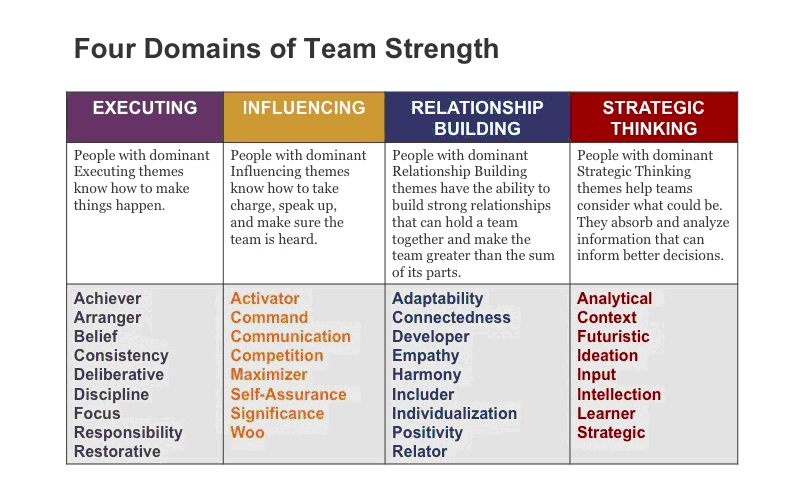How to Discover Someone’s Natural Strengths

Everyone has a set of strengths. Everyone. Some have more than others. Some are more specific than others. But we all have them.
Where our strengths come from is up for debate, but the answer doesn’t really matter. Whether they are within us at birth or learned over the years (likely a combination of both), we have defined our strengths fairly well by the time we’re adults.
Strengths are natural and comfortable. We prefer working on projects that use our strengths and abhor doing things that require out weaknesses.
A lot of people (managers included) make the mistake of focusing on weaknesses. They figure the best way to improve is to compensate for defects. Without underlying talent, however, we will never turn our weaknesses into excellence. Instead, it’s more productive to exercise our innate talents and use them as much as possible.
Productivity coach Ciara Conlon recommends focusing on what we do best. “The Pareto Principle [commonly known as the 80/20 rule] shows how filtering what you focus on can help towards more success. […] If you apply this principle to your whole life, if you were to focus solely on what you do best just imagine the results. […] By directing all your energy on your strengths, this will surely get you the results you aim for more quickly.”

Source: wbdaily.com
Using employees and team members as interchangeable drones is entirely ineffective in nearly all cases, but especially in Customer Success. Workers become unengaged, bored and eventually leave for better opportunities.
There’s plenty of data to back this up. Gallup found that “people who use their strengths every day are six times more likely to be engaged on the job.” They are less likely to experience stress, anger, worry, sadness and even physical pain. When they focus on their strengths, they excel at their jobs, stay with the company longer and improve your bottom line.
The key to managing a team well is to use each person according to their strengths. Assign projects based on strengths, not availability.
But first, we have to identify those strengths.
Interview them carefully
The first place you should start is having a conversation with the team member. Don’t let on right away that you are trying to identify specific strengths. This isn’t to be sneaky, but so you get unbiased information. You don’t want someone telling you they are a keen problem solver because they think that’s what you want to hear.
Ask them about where they have been successful in the past. What have they accomplished that stood out? Where did they excel? What did they find particularly easy to accomplish? What would make them more satisfied if they got to do it every day? Have they done anything that caused a customer to compliment them?
Then, ask where they have been unsuccessful. In what areas have they produced sub-par work? What parts of their job do they dislike doing? Which projects make them cringe or sigh when they get assigned? Have they done anything that caused a customer to complain?
Once you have completed your interview, ask them point blank: “What are your strengths?” Some self-aware people have an answer to this question, but many don’t. You’ll have to push forward with your discovery.
Ask other people
Often, when you ask a person what they’re good at, they can’t come up with anything. It’s tough to identify our own skills because they have always been with us. If a person has excellent communication skills, he has always been that way. It doesn’t feel like a skill.
Instead of trying to pull the information out of your employee, ask the people who work and live with him. Surely they have recognized an instance where the employee performed exceptionally. The information you get from the employee’s colleagues will be useful, but it might require some reworking. For instance, someone might say “John learned how to use our new internal software faster than anyone else.”
John’s ability to use one particular program doesn’t help much, but perhaps John has the ability to rapidly learn new processes. Even if you can’t be sure you have discovered John’s strength, at least you have somewhere to start investigating.
And investigate you should. Even if someone is lauded as particular skillful, it doesn’t mean they actually have those skills. They may have a few successes in the past, but can’t repeat the behavior. So don’t believe everything you hear. Look for patterns.
Have your workers keep a journal
At face value, this feels like a lame exercise, but it can be enormously useful.
Ask your staff to keep a journey for three days. Just three days. If nothing useful turns up, ask them to keep it for a full week.
In the journal, they should keep notes on the basic things they do. They don’t have to be specific. All you need are notes like “exercised,” “ate breakfast,” “commuted to work,” etc.
Have them keep track of anything that made them feel particularly strong or energized. These could be any activities, including things that happen outside of the work.
For example, if your employee feels energized when he cooks a meal, you’ll have somewhere to investigate. Ask him what about cooking that made him feel strong. Does he enjoy completing a process? Does he like improvising? Does he actually prefer the payoff – feeding other people? His answer would lead you to his strength.
Take an assessment
Assessments are challenging because the questions usually can’t be tailored to the individual (at least in online quizzes).
However, the Gallup Strengths Center assessment is well made and useful. It’s not a brief questionnaire. It will take about 25 minutes of your undivided attention.
Unlike other assessments, the Gallup test gives you actionable information. This assessment breaks people down to 34 strengths, organized in order of most to least dominant.

Source: connieleacreative.com
Look through old correspondence
Check old emails, memos or other documentation for instances when an employee was praised for great work. Look for repetitions and patterns.
You may notice, for instance, that an employee has been regularly praised for solving problems for customers before the problem actually arose. This employee has intuition, foresight, and a willingness to improve the customer experience even when the customer can’t see it.
Look for failures in old correspondence, too. Failures don’t identify strengths, but they can tighten up your investigation. If, for example, a team member praised John’s decision making, but John’s old emails are full of admonishments for bad decisions, you would know to discount the recommendation.
The rotating tasks experiment
This isn’t really a formal experiment. It’s a simple approach to discovering the strengths of your team mates.
Simply assign work to team members in a systematic way so everyone gets to try every function of your Customer Success process. For instance, if part of your process involves creating documentation articles, assign a few to everyone. Compare them side-by-side to determine who has the most strength in that area.
The challenge with this test is that you are potentially putting people in positions where they are likely to work inefficiently or ineffectively. It may compromise your output as a Customer Success team. I recommend carefully overseeing the experiment so it doesn’t cause more churn than you’re trying to prevent.
Yes, these tactics may take a bit of time
I know that in Customer Success, you might not have hours to devote to a single project. But the long-term gains to figuring out your team’s strengths is tremendous. It will make your life and their lives much easier. You’ll have the tools to fashion a Customer Success team that is built to serve.
Once you identify a person’s strength, they’ll realize that they’ve always known it, but couldn’t put it to words. Even more – you’ll create a bond between the employee and the leader that’s born out of honesty and recognition.
As part of our CS Strategy Power-up, we’ll show you how to identify your team’s strengths. Contact us today for a more efficient Customer Success team.
